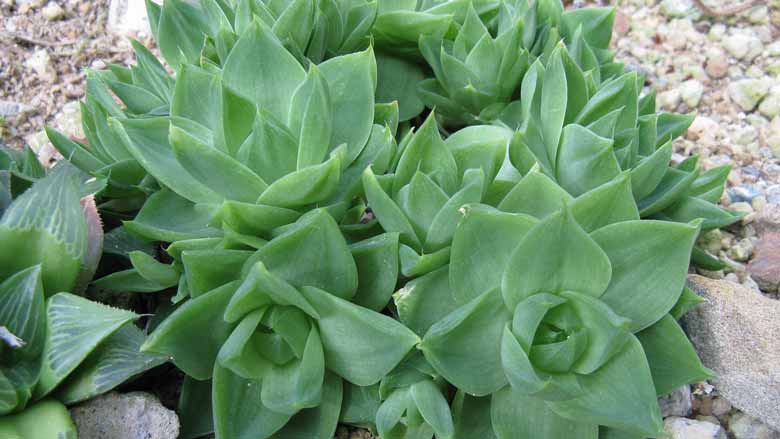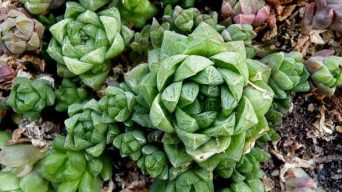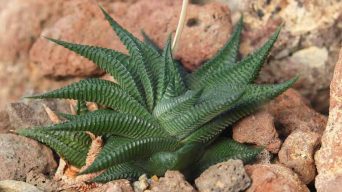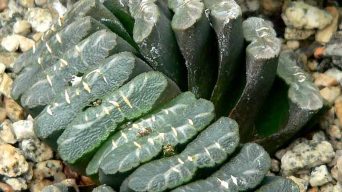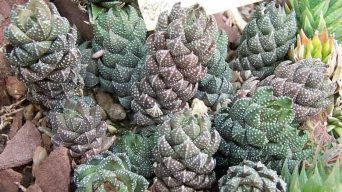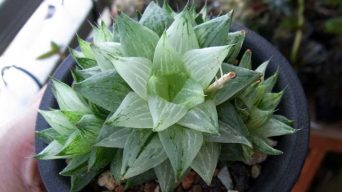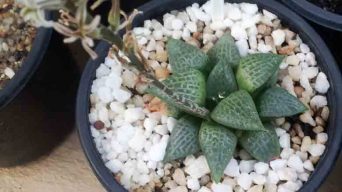Haworthia cymbiformis is a popular succulent plant that is native to South Africa.
They grow in clusters and can form large clumps with time.
This guide will show how easy it is to care for these beautiful plants and provide tips on propagating Haworthia cymbiformis.
About the Haworthia Cymbiformis
The Haworthia cymbiformis is a succulent plant that belongs to the genus “Haworthia.”
It is native to the Eastern Cape Province of South Africa. They grow in rocky outcroppings and sandy soil, which helps them retain water during dry periods.
The Haworthia cymbiformis can grow up to 3 inches tall with an upright or trailing growth habit.
It has succulent leaves with rosettes of evergreen foliage. Their leaf tips are translucent, a trait that is unique to this species and can be used to identify it from other types of Haworthias.
The flowers are white or pink with a pointed throat, also known as an elongated corolla tube that opens at both ends when it blooms.
It is native to the Eastern Cape Province of South Africa. They grow in rocky outcroppings and sandy soil, which helps them retain water during dry periods.
The Haworthia cymbiformis is a drought-tolerant plant, making it a perfect succulent for beginners or the occasional gardener.
How To Care for Haworthia Cymbiformis
Haworthia cymbiformis care is easy to do, but you need to know a few key things.
Sun Exposure & Light Requirements
Haworthia plants prefer bright light but do not need direct sunlight to survive.
They can handle anywhere from a few hours of sun exposure each day up to more than six hours of intense sun on the leaves.
Haworthias should be planted outside, where they will receive full sunshine for most of the day and partial shade during midday.
The best time to move a Haworthia succulent outside is in the spring. This will give it enough time to acclimate before summer starts, and the plants can be sunburned by intense heat during midday hours.
Sun exposure isn’t as big of an issue with indoor plants, but they still need plenty of bright indirect light without too much direct sunlight on their leaves for optimal health.
If you’re growing your plant near a window, then keep them about six inches away from the glass or shade them with sheer curtains or other methods to help reduce intensity when necessary.
They should get at least 4 hours of sunlight daily unless you have artificial lighting. If this is the case, they should limit their sun exposure to four hours a day.
Watering
Haworthia cymbiformis plants are generally watered once or twice a week. Allow the soil to dry in between watering periods.
The amount of water applied depends on the pot size and whether it is planted in a succulent mix, cactus mix, tree bark mulch, clay pellets, or something else.
- Succulent Soil: Water thoroughly so that excess moisture drips from the bottom of your container when you lift it up after watering.
- Cacti Mixes: These need more frequent watering about every other day. They will require more water, so be sure to check the instructions on your pot for guidelines!
- Tree Bark: Water when soil is dry to touch or you see some shriveling, especially in wintertime (December through February). The tree bark mulch should have about 20% of its volume replaced with fresh material every year.
- Clay Pellets: These need watering weekly as they are a type of clay that can absorb and hold in moisture well without becoming soggy.
It’s important that we don’t overdo it with their watering habits.
Remember, these are drought-tolerant, so be careful not to overdo things by giving them too much water!
Soil
Haworthia cymbiformis plants are well-known for their ability to grow in rocky, sandy soil.
As long as the pot has good drainage and can dry out between watering sessions, any kind of potting mix will work.
The most important thing is that it drains water easily.
A Cactus or Succulent Mix soil is often the best choice, as it will provide nutrients and keep your plant healthy.
It’s essential to use a well-draining potting soil mixture that doesn’t retain too much moisture to prevent root rot.
This can be accomplished using a succulent mix of topsoil with peat moss or perlite added for aeration purposes.
Most importantly, there should be about half an inch (12 mm) of gravel or small rocks underneath the soil. This helps with aeration and prevents root rot from occurring due to too much moisture.
Temperature and Humidity
Haworthia cymbiformis is a succulent plant native to South Africa. It thrives in temperatures between 65 and 95 degrees Fahrenheit (18-35 Celsius).
The plant will survive in lower temps but grows much slower, which could be problematic for beginners.
They grow best with high humidity, around 60% or higher.
However, too much humidity can damage the leaves of the Haworthia cymbiformis plant, so make sure not to overwater them!
Fertilizing Your Haworthia Cymbiformis
Haworthias are sensitive to fertilizer levels, so fertilizing should be done carefully.
If you want to feed your Haworthia cymbiformis plant more, do not use too much fertilizer at once, or it will “burn” the roots.
Use a small amount of water-soluble houseplant fertilizer at half the recommended strength on your Haworthia plants once monthly during spring and summer.
If you want to feed your Haworthia plant less, use a quarter of the recommended strength on your plants once per month.
Be careful not to fertilize during winter and then resume feeding in spring or summer if necessary.
Potting and Repotting
Haworthia cymbiformis is a very slow-growing succulent plant. It can take up to five years for it to grow and produce offsets.
This should not be an issue when repotting or potting the plant unless you have plenty of patience.
When repotting your Haworthia cymbiformis, make sure that its roots are in soil that drains well.
The size of the pot is also important.
The root ball should not be too big for the container, or else it will dry out, but nor can you make it so small that there’s no room to grow, and more offsets are created.
The container should also have enough drainage. This is done by either using a pot with holes in the bottom or planting your plant on top of perlite. This will help promote good airflow and reduce water retention inside the soil.
Pruning Haworthia Cymbiformis
Pruning and shaping are two important things that you should do for your Haworthia cymbiformis plants.
You can trim off rosettes, leaves, or stems as needed.
Use sharp scissors instead of a knife so the plant will not be damaged too much! Make sure to cut at a right angle to the stem.
Sterilize your scissors after each cut by dipping them in sterilizing solution and wiping it off with a paper towel or cloth.
It would help if you also trimmed back any leggy sections to encourage new growth from other parts of the plant instead.
If you are removing leaves, use sharp clippers and snip them away as close to where they attach to the stems as possible.
Then take a razor blade and scrape out any excess tissue remaining around the edges of the wound!
This is important because it removes bacteria before it has time to start infecting your Haworthia cymbiformis plants wounds, leading to them being unable to heal quickly or properly!
Pests and Diseases
Haworthias are notoriously pest and disease resistant. They can be grown in the same pot for years without problems as long as it is well-drained.
If you do get hit with a pest problem, the best thing to do is address it immediately.
If there’s an insect issue like mealy bugs, neem oil diluted in water makes for a great organic pesticide that will kill them quickly!
Just spray it onto your Haworthia and let it dry before giving off any odors that might attract more insects, especially during warmer months when they attack most heavily.
To fight off disease, a fungicide may be the best option. Spray it on your plant, and make sure to get all of the leaves.
This helps to prevent any bacteria from getting to the roots.
How To Propagate Haworthia Cymbiformis
Propagating Haworthia Cymbiformis is not difficult. It can be done with one of the following:
- Offsets or small plantlets
- Stem cuttings
- Leaf cuttings
Offsets
The offsets that form on the base of a Haworthia Cymbiformis can be removed by carefully prying them away from the mother plant.
This should not damage either the offset or the parent plant.
They will need to be planted in lightweight, fast-draining soil and watered thoroughly after planting.
They should also receive at least one-fourth inch of water per week during dry periods for good growth and development.
There is no set amount of time between when they are taken from their original location and when they are ready to be transplanted.
It usually takes about six months before transplanting into new homes is necessary.
Stem Cuttings
Haworthia cymbiformis stem cuttings should be taken from healthy plants during the growing season when the plant is actively in bloom.
Cuttings should have at least three leaves to ensure a good chance for success and should not exceed eight inches in length.
The cut end of each stem cutting needs to be cleaned with water before planting into their new home.
After you wet the leaves, let them sit for an hour.
Then, put them on some moist soil and cover them with more soil until three sets of leaves show above ground level.
Stem cuttings will not need to be watered again until they begin producing new roots.
The cuttings can take up to two weeks to grow new roots.
They should be kept in a sunny area but not too hot, or they will dry out and die.
Once rooted, Haworthia Cymbiformis stem cuttings can be transplanted into their permanent home once rooted.
Leaf Cuttings
It’s possible to propagate Haworthia cymbiformis with leaf cuttings.
The leaves may be collected as they fall off the succulent or plucked from a healthy branch.
Then the cuttings need to be placed on top of moist soil in an area where there is shade to keep them cool but not too hot.
Leaves can be left to dry out and die if they are not planted in moist soil.
It may take up to two weeks for them to grow, but the new plant will have a single stem and many different leaves sprouting from it when rooted.
The leaf cuttings should then be transplanted into their permanent home, where full sun is exposed for at least half of each day.
This method is most successful during the fall or winter months before growth begins again in the springtime.
Haworthia cymbiformis plants also need heat throughout autumn, as this time of year lasts until late February. Hence, you want your cutting to develop while still getting warm air and sun.
Is the Haworthia Cymbiformis Toxic?
The Haworthia Cymbiformis succulent plant is not toxic and can be used as a safe houseplant.
This succulent plant is safe for use around pets and children.
Final Thoughts
In conclusion, Haworthia Cymbiformis is a succulent that’s easy to care for, and propagating it doesn’t require too much extra work.
It has a soft texture and is an excellent plant for someone who wants to get into succulent gardening but isn’t sure where to start.

